I have not added to Shooting From the Hip in a while, but it was not without reason. I recently acquired a new camera, the Samsung Q10 camcorder, which I hope to be using in the near future to begin filming video segments for SFTH. I am still getting acquainted with it, but I think it will be a great little camera, and I used its still shot capability for today's entry. And be warned: today's entry is a little long, because we are going to go in depth on this particular firearm, but I hope it is beneficial to some of you out there.
Speaking of today's entry, I have decided to look at one of my more recent acquisitions, considered by some to be an "obsolete" firearm, but which I have found in the short time I have had it to be anything but obsolete. It is the Remington 878 Automaster. I know several of you may be scratching your heads thinking I must be mistaken, but this is not a misprint. Everyone has heard of the model 870 Wingmaster, one of the finest pump-action shotguns ever produced. Very few have heard of its sister, the 878 Automaster, a semi-automatic shotgun based on the 870 architecture. And with good reason... the 878 was only manufactured for five years, with somewhere in the neighborhood of 63,000 (give or take a few) Automasters produced. These were heady days for Remington, a company at the top of its game and which was putting out some of the finest firearms in the world. It was also a time for innovation and experimentation, and Remington was making the most of it. During the early part of the 1960s, Remington was manufacturing and marketing no less than four different autoloading shotgun designs: the model '48 ('48 - '68), the model 58 ('56 - '63), the model 878 ('59 - '63), and the model 1100 ('63 - present). Eventually, the 1100 design won out, but many feel that all of their designs were effective platforms.
The 878 utilizes a gas piston operated by siphoning off combustion gases from the barrel. Two gas ports located in the barrel ring direct the gases down into the magazine cylinder, where the piston assembly is located. The piston is then forced backward, operating the action bar which opens the bolt, ejecting the spent round, while the next cartridge is pushed out of the magazine, into the receiver. The piston return spring then forces the piston and action bar back forward, allowing the bolt to return into battery, directing the new cartridge up and into the chamber. It is a slick, easy action in operation, and the mechanism greatly reduces felt recoil as so much energy is redirected into operating the piston. And, unlike the model 58, there is no need to adjust the gas feed for different power cartridges.
One downside to having the piston located in the magazine cylinder, however, is that the capacity of the magazine itself is reduced. The 878 has a magazine capacity of two shells (with one in the chamber making a total of three shots) -- the space that in the 870 is taken up by shells three through five is now home to the piston assembly and the return spring. This is not an issue for me in that I am limited to three shots by law for migratory birds, anyway. And since the 878 was designed to use 2.75" shells only, I will not be using it for turkey or deer hunting, so migratory birds and clay pigeons will be my primary use for this gun.
My Automaster is a 12 gauge, 28" barrel with a fixed modified choke. I of course got it used, and it came with no paperwork, so I called Remington to obtain a copy of the owner's manual, which they are sending me (more on this later). According to the very friendly and helpful gentleman I spoke with at Remington, it was manufactured in 1960. There is some light rust in one spot on the receiver, as well as a small spot on the bolt, which I need to touch up, and the bluing is a bit thin in several places. The wood is nice, but has several dings and scratches which I need to address, as well. All in all, not too bad for a gun made fifty-one years ago.
I had a chance to test the Automaster by shooting some clays a few days ago. I was using Remington Lead Game load, 12 gauge, 2.75", 7/8 oz., 7 1/2 shot... a very light load, which is what Remington recommends for this gun, as today's modern loads may be a bit too heavy for the antiquated gas system to handle. I fired fifty rounds through the gun, without any malfunctions of any kind. The action cycled well, very smoothly, ejecting the spent shells several feet away from me, even considering the light loads I was using. As I said above, the felt recoil was negligible... not like shooting a 12 gauge at all. The gun is very light, mounts easily to the shoulder, and the 28" barrel swings very easily and smoothly. The trigger pull is fairly light (ahh, those were the days when guns were designed by shooters, not lawyers), and there is no slop in it either. I had no problems slapping it as I was swinging through the clays. I was very pleased with the gun's performance (my own performance, however, is a different matter altogether).
Now, you may be asking yourself, "I thought you said there were going to be pictures." I am coming to that. One of the only issues I have had with this gun is finding out how to clean it. Anyone who has had a gas-operated firearm knows that in order to keep the gun functioning properly, one must keep the gas system clean. Now, for the life of me, I could not figure out how to remove the gas piston so that I could clean it. So, naturally, I hit the internet to find out how to do so. And much to my chagrin, I could find no information at all on this shotgun. Oh, there are plenty of people out there who are more than willing to sell you a copy of an owner's manual, or a copy of a schematic, or a copy of two pages from an American Rifleman magazine from 1961 that shows how to take down the 878 (for a mere $4.98 + $3.00 shipping, I might add). This just burns me up. But, based on the condition of the outside of this gun when I got it, I was naturally concerned about the inside of it as well, so I broke down and bought a Remington Arms Factory Gunsmith Service Manual for the 878 (turns out it was a copy, as well) for a measly $11.25, shipping included.
Now, we live in an age where information is power. And I just spent eleven bucks in order to get some information that should be available for free (granted, Remington is sending me the owner's manual for free, so kudos to them... it is service like this that keeps me coming back to them). So I am going to post a series of photographs showing you how to disassemble the model 878 to remove the gas piston for cleaning, so hopefully no one will have to pay outrageous prices for photocopies of gun manuals again. (It should go without saying that if you the reader are not confident in your ability to disassemble and reassemble any firearm properly, you should seek the assistance of a trained professional. If you choose to continue, you alone are solely responsible for any mishaps, including injury or death, that you might experience as a result of failing to properly reassemble your firearm. In other words, I assume no responsibility for your mistakes.)
First, here is the 878:
Before working on any firearm, check to make sure it is unloaded... then check again.
Now, first, remove the magazine cap by unscrewing it.
Once the cap has been removed, the barrel and forearm may be removed by sliding it forward out of the receiver.
Now, the forearm may be removed from the barrel by sliding it off of the barrel ring.
Here are the twin gas ports inside the barrel ring. You need to make sure that these are clean and free from obstructions.
Here are the corresponding ports on the magazine cylinder. Again, make sure to clean them out. Also visible, the action bar on the outside of the cylinder, which is connected to the piston assembly inside the cylinder.
Here, I have opened the bolt, which pulls back the action bar and piston, to show the removal notch at the end of the action bar slot. Note: The bolt must be closed in order to proceed with take down -- I have only opened it here for clarity. In order to remove the piston, the action bar must be released, allowing it to slide forward to that notch where it can be separated from the piston assembly.
Here is a shot of the action bar, showing the retaining stud which connects the action bar to the piston. When the action bar is all the way forward to the removal notch, the front of the action bar is lifted up, removing the retaining stud from the piston assembly, freeing it for removal.
Now, to free up the action bar, first make sure the bolt is closed. Next, you will reach into the receiver through the loading hatch on the bottom, and press in on the left side shell latch. It is a flat bar located just inside the receiver, inside a groove against the side of the receiver. Press the latch in against the side of the receiver, and you will feel it release, and hear a "click," after which the action bar may be slid freely forward to the removal notch.
Here, the action bar has been slid forward to the removal notch. You can see the tip of the piston sticking out of the end of the cylinder at this point.
Holding onto the piston, lift up on the action bar to pull the retaining stud out of its slot in the piston assembly. Note: The piston assembly is under pressure from the return spring! Make sure you retain control of the piston or it might be ejected violently from the cylinder, resulting in injury or property damage.
The piston assembly and return spring may then be removed from the cylinder. The retaining stud slot is now visible as a round hole on top of the piston.
The return spring may also be removed from the piston by sliding it out of the end of the piston.
The piston, spring, and cylinder may now be cleaned. A note on the bottom of the cylinder says that solvents and oil should not be used on the piston or the inside of the cylinder. How one is supposed to clean these parts without solvent, or protect from rust without oil, is a mystery to me. I just used a brass brush to knock the caked powder residue out of the cylinder and off of the spring and piston, wiped them off as best I could using a clean cloth, gave it a little shot of Rem DriLube (teflon), and called it good.
To reassemble, simply put the piston and spring back into the cylinder, push in on the piston until the slot and retaining stud are aligned, then push the stud into the slot reconnecting the action bar to the piston. Open the bolt, which will pull the action bar back, along with the piston, and the shell latch will return to its normal position. Slide the forearm back onto the barrel. While the bolt is still open, slide the barrel and forearm back into place making sure the barrel is fully seated into the receiver, then screw the magazine cap back on. Release the bolt by pressing in on the magazine follower. And you are done. It is not difficult at all once you know how to do it. When I get around to removing the bolt, I will post pictures of that process, as well.
All-in-all, I am happy that I was able to get this particular gun, as much because of its significance as a piece of firearms history, as because of its fine handling and performance. I think it will make a fine skeet gun, as well as for doves and upland fowl. So for those of you who are looking for a good autoloader for such applications, you might consider a good used Remington 878 Automaster... if you can find one.

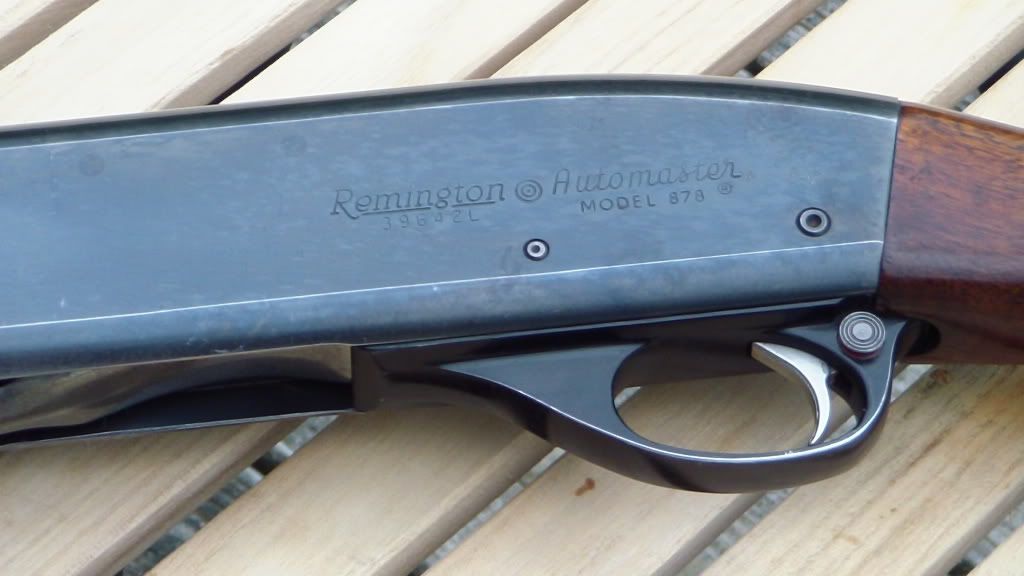
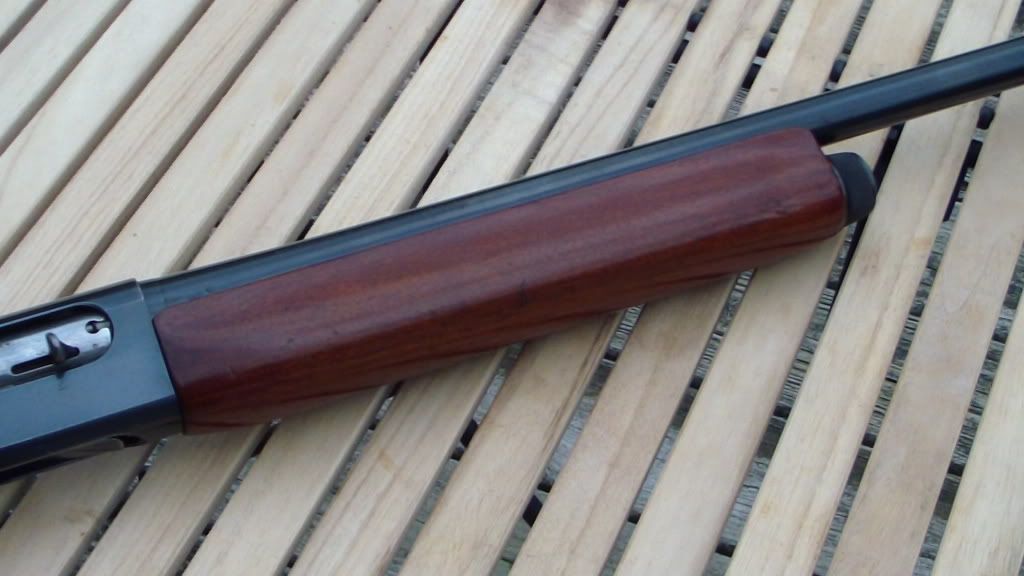
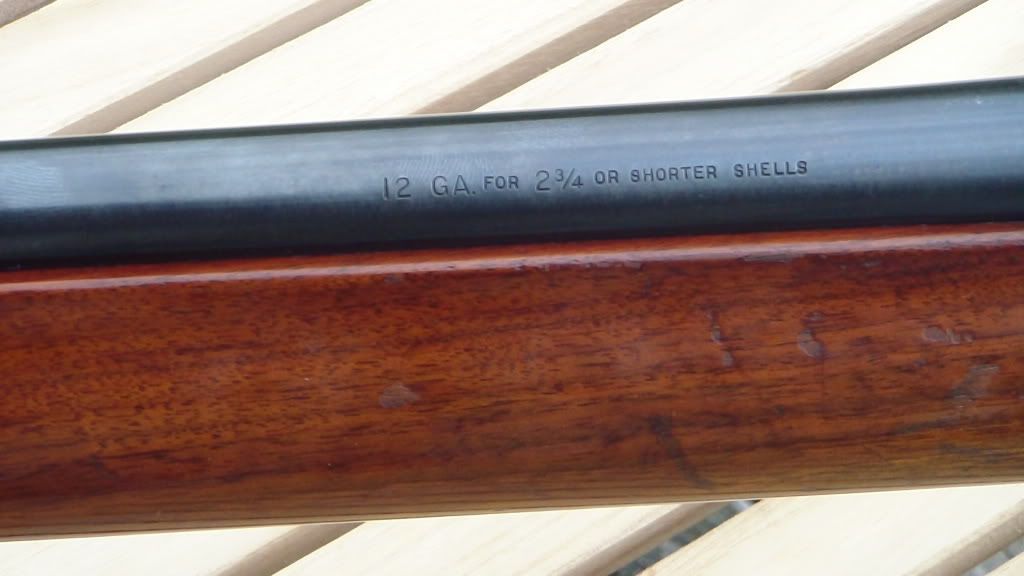
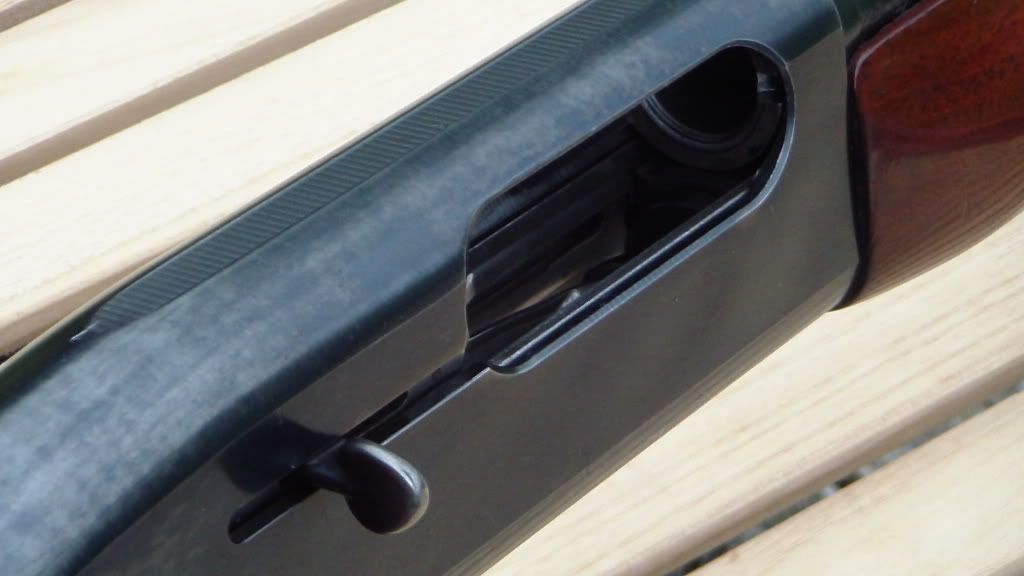
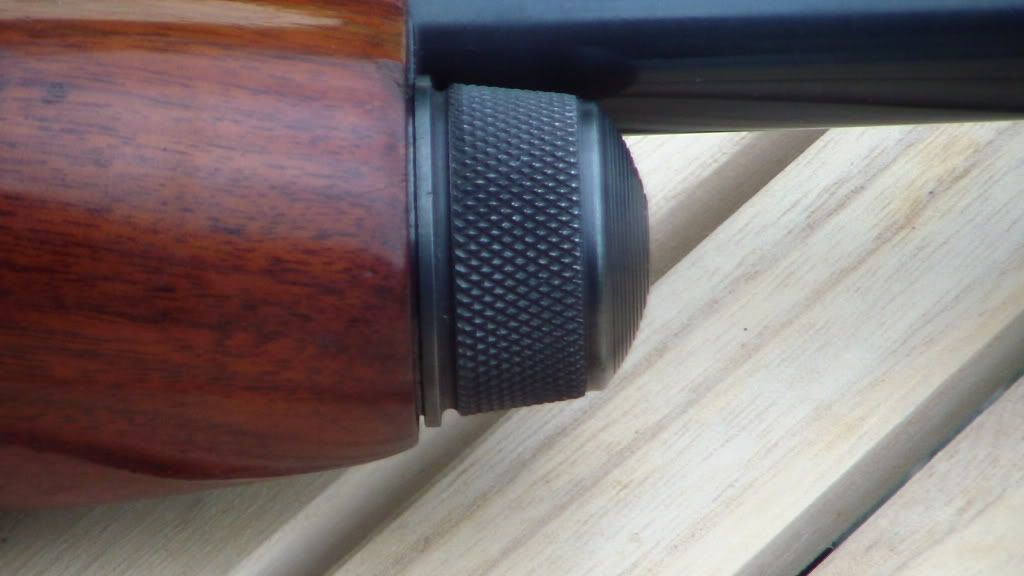


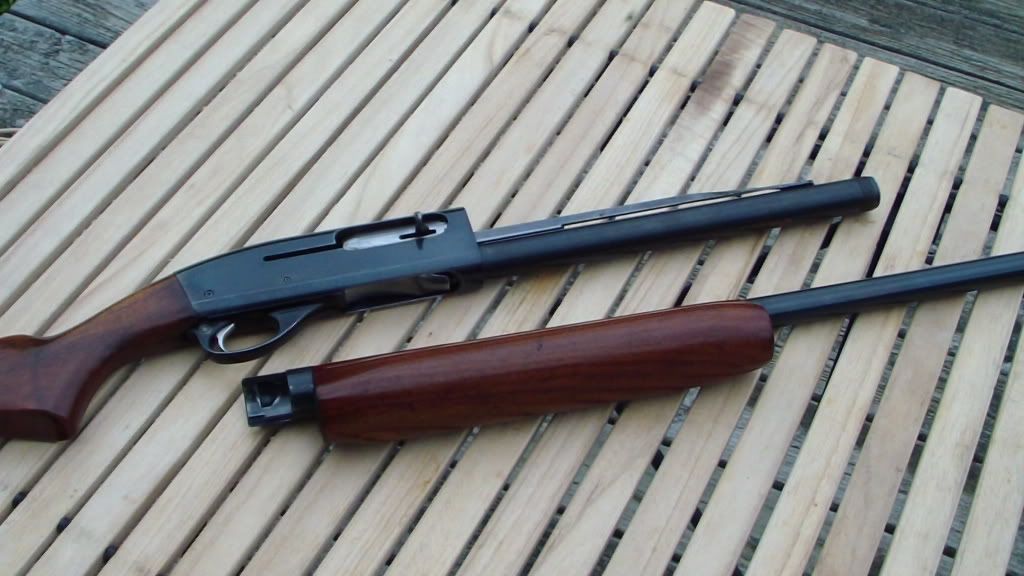
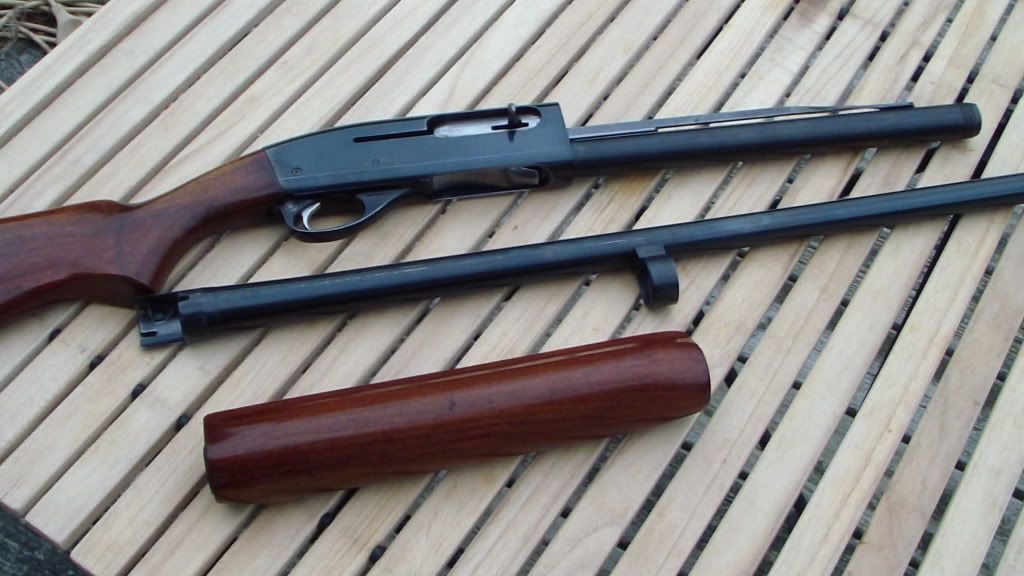


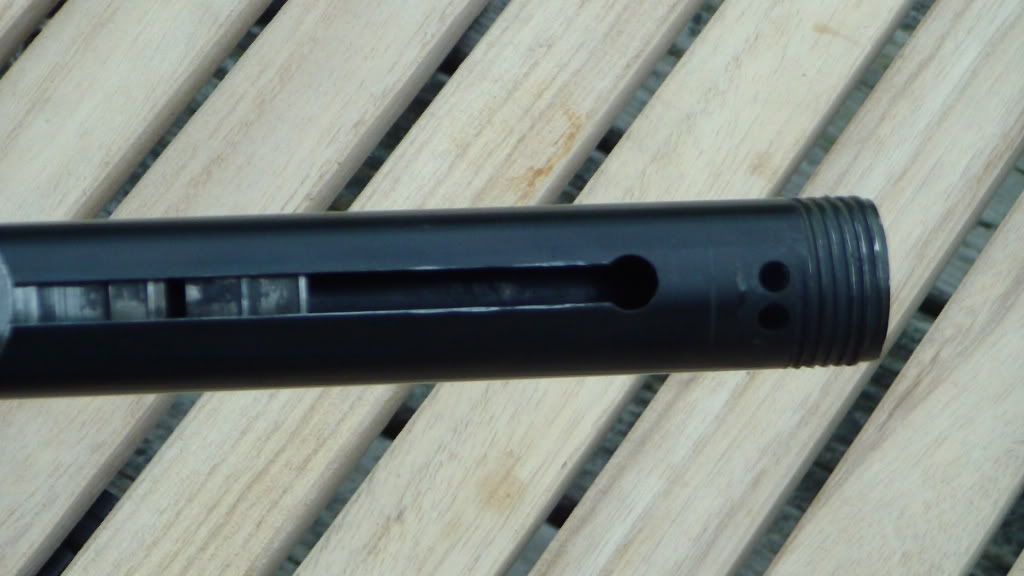






THANK YOU FOR THIS INSIGHT. DO YOU KNOW ANYTHING ABOUT THE WINCHESTER 140 20GA? I CANT SEEM TO FIND ANYTHING ABOUT IT.
ReplyDeletethis was the low cost version of the standard Winchester model 1400 auto.
DeleteI appreciate your post; I am shooting an 878 that was my fathers that he purchased new in the early 60's... He shot competitively in the 60's and continued using the gun for wingshooting until his passing this year. There is no telling how many rounds he cycled through this gun, but I have logged at least 1000 rounds in the last two weeks including the 200 today where my wife and I shared the gun for a round of sporting clays... Not one failure!
ReplyDeleteAnyway, was scared to clean due to the oil comment on the tube. Thanks for the info!
Great post - thanks!'
ReplyDeleteHave you gotten around to taking down the bolt?
Thanks for all the comments! Sorry I have been neglecting the blog of late, I am working on a few items to get back into the swing of things in the next week or so.
ReplyDeleteCassie -- sorry, I have no experience with the Winchester. Actually, at the moment, I do not own any Winchesters... I need to remedy that soon! If I find any info on the Model 140, though, I will pass it along.
Anonymous -- I have not disassembled the bolt yet. I actually have acquired a couple of new shotguns that I have been working with during the last couple of months, so I have not had the 878 out much of late.
Jay H. -- glad you are enjoying the 878... they really are well-made guns. If taken care of, you will probably be able to pass it along to your own children as well!
Regarding the bolt referred to above, do you have the technical data and procedures available? I am fairly comfortable with restoration up to the points covered in your pictorial review. I recently acquired the 878 from my father who bought it used in the mid 60's. He is now in his mid 80's and is in declining health. This poor weapon suffered years of neglect having been one of his very few possessions salvaged from the 1972 Hurricane Agnes flooding in Elmira, NY. I would like to take him to the range one last time, even though he is no longer able to fire the weapon. I just know seeing the weapon in action once again will leave him with a broad smile on his weathered face. Yes, the smile. Priceless memories!
ReplyDeleteJust picked up an 878 automaster for $80 thanks to all the help found in this forum. Thank you so much gun toting vigilante!! going to take it out saturday and see how she works.
ReplyDeleteCongrats on your purchase!! And what a great price... one can often get great deals on some of these older, used shotguns, since so many new shooters are stuck on having higher capacity magazines and actions chambered for the newest super-extra-magnum loads that will vaporize a bird on the wing. Give me an old Remington 878 or Browning A-5 with some "character." Anyway, I hope you enjoy your new-to-you shotgun as much a I love mine. And thanks for checking out my blog. I hope to add some more reviews very soon. PS. I have had very good results using the Winchester bulk pack target loads from Wal-Mart.
DeleteI also bought an878 but was told that I could use deer slugs and buck shot I would like to know if it is safe I just bought the shotgun thank you Bob M.
ReplyDeleteI would say it depends on the loads you are shooting. The Remington rep I spoke with advised me to stick with light loads, as the commercial loads available at the time the 878 was developed were much lighter than those in current production. The major factor you need to take into consideration (after your personal safety, of course) is the fact that parts for these guns are VERY hard to come by, and a lot of gunsmiths have no experience with these shotguns, so repairing a broken action could be difficult, and perhaps cost prohibitive. I would advise you to contact Remington directly at 1-800-243-9700 and ask their opinion... the reps I have spoken with have always been very helpful.
Deletethank you so much. i to have tried to find info on this gun. i just purchased it yesterday, and tried it today. it shoots fine except sometimes it jams like it is trying to push two shells at once. i will try your cleaning tech. thanks again. remington 878 12 gauge semi
ReplyDeleteI've had this shotgun for 10 years shooting grouse, geese, ducks, pheasant, and clays. It's definitely a tough old gun, its NEVER missed a beat, misfired, or jammed. A lot of people knock it cause it wont handle 3" shells but it dont need to if your decoys and calls are lifelike enough!!
ReplyDelete878 rem automaster Magazine/Piston problem
ReplyDeleteOn the 878 the magazine assembly (magazine follower and spring) and the piston assembly (piston and spring) are both housed in the same tube separated by plug called the ACTION SPRING STOP. Now dismantle the gun and remove the piston and spring. You will note when looking at the outside of the receiver (the tube that houses both assemblies you will see a small vent hole and just above it 3 dimples in the tube.
Is the ACTION SPRING STOP is supposed to be positioned at those dimples.
What is happening is that the action spring stop is being pushed into the magazine (due to the piston recoil) which then relieves the necessary pressure on the piston spring (Action Spring) and is more pressure on magazine spring. What this all means is that you cannot load 2 shells into the magazine AND your shells won't be loaded or ejected properly AND your breach bolt will not close properly because there is not enough tension on action spring. As the spring stop is pushed farther into the magazine the piston spring gets longer thus weaker.
I had to take the stock off so I could ramrod the mag assemble to get the STOP back to the dimples.
What is supposed to hold the ACTION SPRING STOP in place.
If you have the answers please call me at 906 374 0745 or email me at
uppermichigan@hotmail.com
I just bought one of these guns and was told it had been sent to remington and had a smooth bore slug barrel put on it??????? Help please I was told not to shoot anything other than slugs out of it
ReplyDeleteI was unaware that Remington produced "smooth bore slug barrels" for these shotguns. You should be able to tell what choke your barrel is by looking on the left side of the barrel, just above the fore end, about 1/2 inch from the receiver. There will be a series of proof marks, and above that, there should be a choke code: on mine, it is marked "MOD." for modified. If the barrel is unmarked, or if you are unsure, I would advise you to contact Remington directly at 1-800-243-9700. The representatives there have always been helpful when I have contacted them.
Deleteold system of telling if its full choke was if you can fit a dime in end of barrel its not full either modified or open
ReplyDeleteThanks for this bit of information! This is what the internet is supposed to be about! I found myself in the posession of one of these, and wanted to double-check with some of the information listed above based on the pictures. You said this gun only fires 2.75" shells, and it says the same thing on the barrel of the gun. Mine doesn't say anything about shell size on the barrel engravings. The ID number is in the 60,000L series... could that mean that there's a difference in shell size shootability? Any additional information would be greatly appreciated! Thanks for this posting
ReplyDeleteThanks for the comment! Based upon the information I received from Remington (the owner's manual included) the 878 was only chambered for 2.75". It is possible that your shotgun has been fitted with a replacement barrel, with a different chambering. My recommendation would be to give Big Green a call with your serial # and ask them, just to be on the safe side (1-800-243-9700).
DeleteThanks for the info....very helpful.
ReplyDeletewhat do u l h a markings on the barrel mean? I know A is field grade but that is it
ReplyDeleteI am not sure about the markings you are describing. If you contact Remington with a description of the marks and their location on the barrel, they should be able to give you the information you seek.
DeleteI really appreciate the knowledge about the guns, Keep it up and am looking forward for more guns review like this.
ReplyDeleteHey there GTV, and GTV fans....this YouTube video was a tremendous help to me....it's from some guy named Njaln in the Faroe Islands - Europe /Denmark..I guess in the Faroe Islands they also love their 878 Automasters...LOL...Enjoy the video!! If the video was helpful log into YouTube with ur GMail account and thank Njaln!!
ReplyDeletehttp://www.youtube.com/watch?v=ygtW-uw8g-8
I, too, have one of these fine pieces. Used it for pheasant hunting in South Dakota for quite a few years . . . If I recall, SOME of the parts are interchangeable with another model (58? - but I'm retrieving from a dark recess in my memory) . . . I've had mine apart quite a few times - as stated earlier, keep it clean - use moderate loads and it should shoot for many years to come !
ReplyDeleteWhat is a fair price for the Remington 878?
ReplyDeleteThanks for a fine review of my favorite shotgun. I've got a few too. It was my father's and he gave it to me to use when I was in highschool in the mid 60's. It's got a 26" imp. cyl. I have shot this gun SO many times since then and NEVER, not once have I had a malfunction. I hadn't shot it in awhile and went duck hunting this past Saturday morning. We shot woodies coming in over decoys. If you know how to shoot it'll kill'em. It looks pretty rough to be honest, a split in the foregrip and the stock is beat up and doesn't have any luster to it at all. It's got worn areas on the barrel and reciever too. You can't hurt it though. I just don't have to worry about it and I like it that way. I have been considering getting 28" mod. barrel for it though.
ReplyDeleteI now have a Remington 878 and was wondering how to break down this type of shotgun. I have had semi auto shotguns before this is built differently. if anyone can help me that be greatly appreciated
ReplyDeleteI had an 878 in Jamaica. It was my first gun, and also my last. I bought it used from a friend when I was 18 years. I have used this gun in swamps, over baited dove fields, in the hills and in the deep forests. Shot everything from dove, wild pigeon (white crowned pigeon) and wild boar. I used everything from no. 7.5 birdshot to Remington express #6 and slugs. Never had a problem.
ReplyDeleteThough temptation was great, I resisted buying a new model 1100, especially when my friends were spending a lot of time in the field clearing jams and misfeeds. One productive day saw me running over 300 rounds in about two and a half hour without a hitch. At times like that, the low recoil factor was greatly appreciated. I wish they would still make guns like this. I would buy one in a shot (pardon the pun).
As we say in Jamaica, the 878 - No Problem, Man!
so what would be the biggest load u would shoot thru the 878?,maybe a #6?
ReplyDeleteI have shot Remington 2 3/4", 1290 fps, 1 oz, #6 Game loads before, but would probably not go much heavier. I stick to less than 1 1/8 oz. loads, personally... anything heavier and I get out my 12 gauge pump. Also, I stay away from any loads that advertise extremely high velocities. I like this gun too much to risk breaking it.
DeleteCan you tell me what the numbers/letter means under the word "Remington", for example 8064L. Is that a production number? You mentioned above the 878 was produced from 59-63. If the 8064L is a production number how would I find out the year it was made?
ReplyDeleteThanks.
A couple of comments: First, about the Winchester 140 - I have a Winchester 1400 Mark II that belonged to a now-deceased friend, and I find it a very sweet shooter indeed. The KEY to optimal performance is keeping it CLEAN, and it is EASY to disassemble. Start taking it apart & it all becomes obvious. I have heard scuttlebutt that the 140 is supposed to be a less-expensive-to-manufacture version of the 1400. Engineers (I AM one) are always looking for ways to reduce production costs, and I would not worry one bit about your gun's toughness or dependability. Shoot it, clean it, and enjoy it - and it SHOULD last.
DeleteNow about the 878: I got a chance about two years ago to get one, so I countered the seller's asking price & he accepted. And I am THRILLED about the gun's handling. It shoulders so naturally & quickly! What a pleasure to use! I'm a little bummed about having to use light loads only, but I consider this gun a work of art AND a pleasure to use. IF YOU EVER HAVE THE CHANCE TO BUY ONE, DO SO - YOU WILL NOT BE DISAPPOINTED.....Fred
I bought my 878 back in the 60`s,and had a DeLuxe P0ly choke
Deleteinstalled,over all length of barrel 26 inches.This 878 has never had a malfunction of any type.I live in MIchigan,and did a lot of
bird and wildfowl hunting.I`ve run hundreds of shells,as I reloaded my own.I`ve shot light, medium,and mag shells.The
878 will handle all of them.I`m now 85,and have not hunted these
past 5 years.My 878 is ready for a new home,if interested,e-mail
me, sagexx2@aol.com--------- My name Henry Faiola
I stumbled across this site today while searching for a part for my Remington 878. I bought my gun second hand as a teenager in the mid-1960's. I have used it for many years. I am now in my mid 60's. It has always been a great gun and I never had any trouble with it except one. Several years ago, I pulled the operating handle back to load a shell into the chamber and the handle just broke off. Given that I was not using the gun to hunt at that time, I just put it aside and didn't get it fixed. I would now like to get this gun fixed so that can use it to hunt again and I would like to leave it to my grandson when I leave this earth. Does anyone have any information as to how to break down this gun to replace the operating handle? If so, could you please post the information on this site? I hope that I can find the part to replace. I plan to call Remington next week to see if they can help me find the part.
ReplyDeleteThanks for the comment! Here is a link to a YouTube video showing how to disassemble the 878 (full disclosure - not my video, but quite useful):
Deletehttp://youtu.be/ygtW-uw8g-8
If the operating handle broke off, you will likely have to use needle nose pliers or forceps to remove the broken piece from the bolt.
Also, Numrich Gun Parts lists the operating handle on their website listed as in stock for $13.30. Here is a link to the page:
http://www.gunpartscorp.com/Manufacturers/Remington-33454/Shotguns-37896/878-41221.htm?page=3
There is a handy schematic on their site as well. Hope this helps.
Hej! Jag ärvde en 878 efter min svärfar och skulle behöva nya fjädrar till den. Finns det något bra ställe i Sverige att köpa delar ifrån? Eller vet du någon bra butik i La Usa då jag har en kamrat som ska dit.
ReplyDeleteJag är rädd att jag inte känner till något återförsäljare i Sverige från vilken att köpa dessa delar, men här i USA kan du ofta hitta fjädrarna på följande webbplats:
Deletehttp://www.gunpartscorp.com/Manufacturers/Remington-33454/Shotguns-37896/878-41221.htm
Hi everyone I have recently aquired a rem 878 I cleaned it as well as I could using the pictures and comments here and the gun operated well for maybe 100 rounds while dive hunting over the course of two days today though after
ReplyDeleteMaybe about 30 rounds the bolt would fail to return fully back to battery and wouldn't fire I unloaded it and found the bolt was sluggish my question is is it normal for it to be this dirty after
That few of rounds were fired
Through it and am I correct in thinking that it is just dirty or am I possibly facing bigger problems
I would be interested to know what loads you were shooting. It is possible that the gun is just dirty, causing the bolt to drag. After your initial cleaning, did you lube the gun well? If you used oil on the bolt, you might consider using a good gun grease, as grease usually lasts longer, especially if you are doing a lot of shooting. I suppose it is possible that if the load you were shooting was too heavy, it might compress the action spring, resulting in a failure to return to battery. If you are at all unsure, my advice would be to have your local gunsmith check it out.
DeleteI was shooting Winchester superx 7.5 shot one oz loads as well as estate 7.5 size one oz load and rio size 7.5 one oz load I don't have the velocities as I'm currently away from home I did oil the gun but I may want to try a better oil maybe the grease would be good could u recommend a good grease to use the high temps that we have where I'm at as well as the humidity can be tough on guns as this is my first auto loading shotgun u could say that I am behind the curve here a Lil bit I haven't had a chance to completly open the gun up yet as I have been away from home but hoping to have time tomorrow
ReplyDeleteHey I love this info
ReplyDeleteI just purchased my 878 at an auction last week and have already killed a have dozen ducks. I love it. My question is have you ever seen an 878 with engravings of two dogs on the left side with pheasant in there mouth and one dog with a duck in its mouth with a water scenery with three ducks leaving the water on the right side?
Yes Remington made upscale versions of the 878 in an ADL model and on up. Does your have the ribbed Barrel ? For those who are unaware of this the Remington 878 Automaster was manufacted again from 1967-1970 under contract to Montgomery Wards as the Western Field 600A ERI and has the exact same engraving on the reciever you described . There were only 9291 manufactured. And I won one !
DeleteI found this page when I was stumbling around on the net trying to find out if Remington ever made any 878 butt stocks that had pistol grip checkering identical to the Sportsman 58 which was it's predecessor, which was produced from 1956 to 63. The information I found in Paul Wahl's "Gun Trader's Guide" (issue 10th Edition dated 1983) states that the 878 came only with a plain (un-checkered) stock. I have found errors before in this publication so I am hoping that some of you 878 guys can shed a little light on this. It seems that the stocks should interchange and be pretty much the same if the 878 receiver is relatively the same as the 870 receiver which the SPT-58 was built on. Any help on this one would be appreciated. And, yes, I always have to remember to set the magazine cap regulator on the old 58 when I go from low base to high base shells. But this old 58 has been very reliable for upland birds through the years. For any help, thanks in advance.
ReplyDeleteI purchased my 878,new in the 60`s, # 18,000L,it had the forearm &
Deletestock checkered.
I just picked up a 878 today at the local gun show.
ReplyDeleteI think it is Very Cool!
It has the 18" barrel and the coolest part is the stock.
It is marked US MARSHAL SERVICE.
Also marked with another number, I believe to be an ID number for the US Marshal Service.
Also has 2 Eagles with stars.
I had to buy it, as soon as I saw it!
Cleaned it tonight when I got home.
I am shooting it tomorrow.
Mike
I have a Model 58, which is in excellent condition, and has engraved scenes on both sides of the receiver (sounds similar to the one above). The wood is figured walnut. They really don't make them like this anymore. I really appreciate the pics of the action and gas assembly taken down. As best I can tell, the Model 58 and 878 look identical except for the piston and the adjustable end cap on the 58. The 58 also does not have the slot in the piston, where I'm assuming that gas is vented on the 878. On the 58, gas vents out of the end cap towards the muzzle. From visual observation, it would appear to me that the 58 would run cleaner, as gas doesn't get forced into the piston tube. Both are great guns, and point and swing great.
ReplyDeleteI love old guns...wouldn't trade this one for anything! Great review! Thanks
I bought an 878 from a friend about 10 years ago for $200. I thought the price was a little high but shot the gun and it was accurate, never jammed, and was a pleasure to shoot. I recently took inventory of my guns and noticed the very short serial number (7051L) and realized I might have an older shotgun. Thanks to your blog and other sites I know to be more careful with this shotgun. I tend to use High Brass loads (4,6, 7-1/2) which apparently could damage my 878. I hate to buy ammo just for this one firearm but it might be worth it given the performance of the 878. Thanks for the info.
ReplyDeletewas all the 878 modified?
ReplyDeleteAre you asking if all of the 878s came with Modified chokes? If so, the answer is I think not. It is my understanding that a variety of chokes were offered.
DeleteThe Remington Model 878 was available with all three basic choke constrictions. Most of the guns I have seen have non checkered stock. But they were available with checkered stocks the same as the Remington Model 58 ADL. They were the Model 878 ADL. Plain or ribbed barrels were available. Also there were game scenes on both sides of the 878 ADL receiver that were different from those on the Model 58. The 878 barrel orifice sizes were different than the Sportsman 58. So barrels were different for the separate models. The barrels most certainly have been interchanged. Don't have an 878 but have two 58's. Barrels made after 878 were introduced had 58 or 878 stamped on the barrel guide ring to identify which gun they were intended for The piston was different between the guns and only the 58 needed the indexing magazine cap .Don't have an 878 but have two 58's. They shoot well but I have had some jams, so looks as if the 878 was an improvement in functionality.
ReplyDeleteVerbatim from OM.
ReplyDeleteThe Remington 878 is chambered to shoot the 2 3/4" shell in light or heavy loads. Modern heavy loads such as REMINGTON "Express" or PETERS "High Velocity," including the standard length 2 3/4" MAGNUM, may be used in your new Remington 878. Three shells may be loaded into your gun, two (2) in magazine, one (1) in barrel.